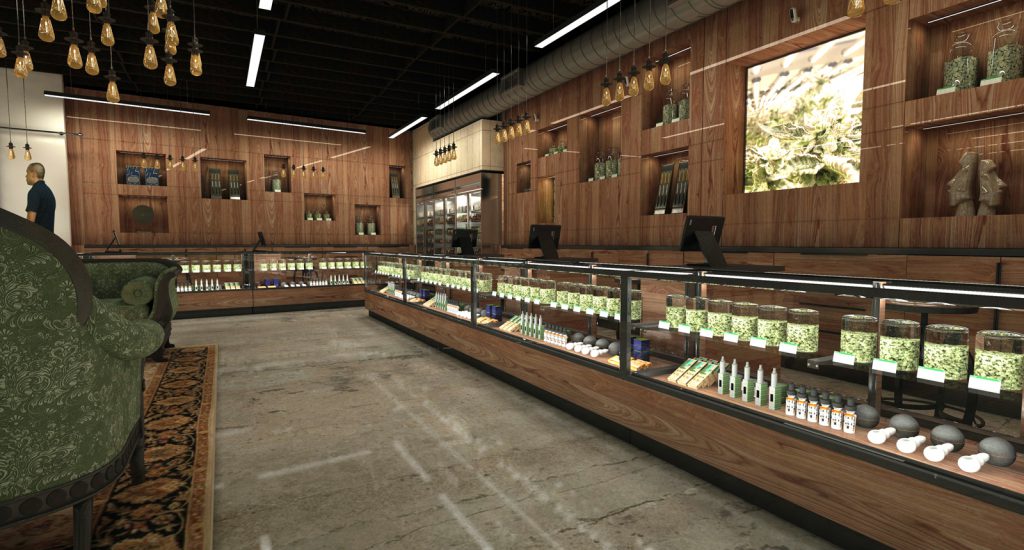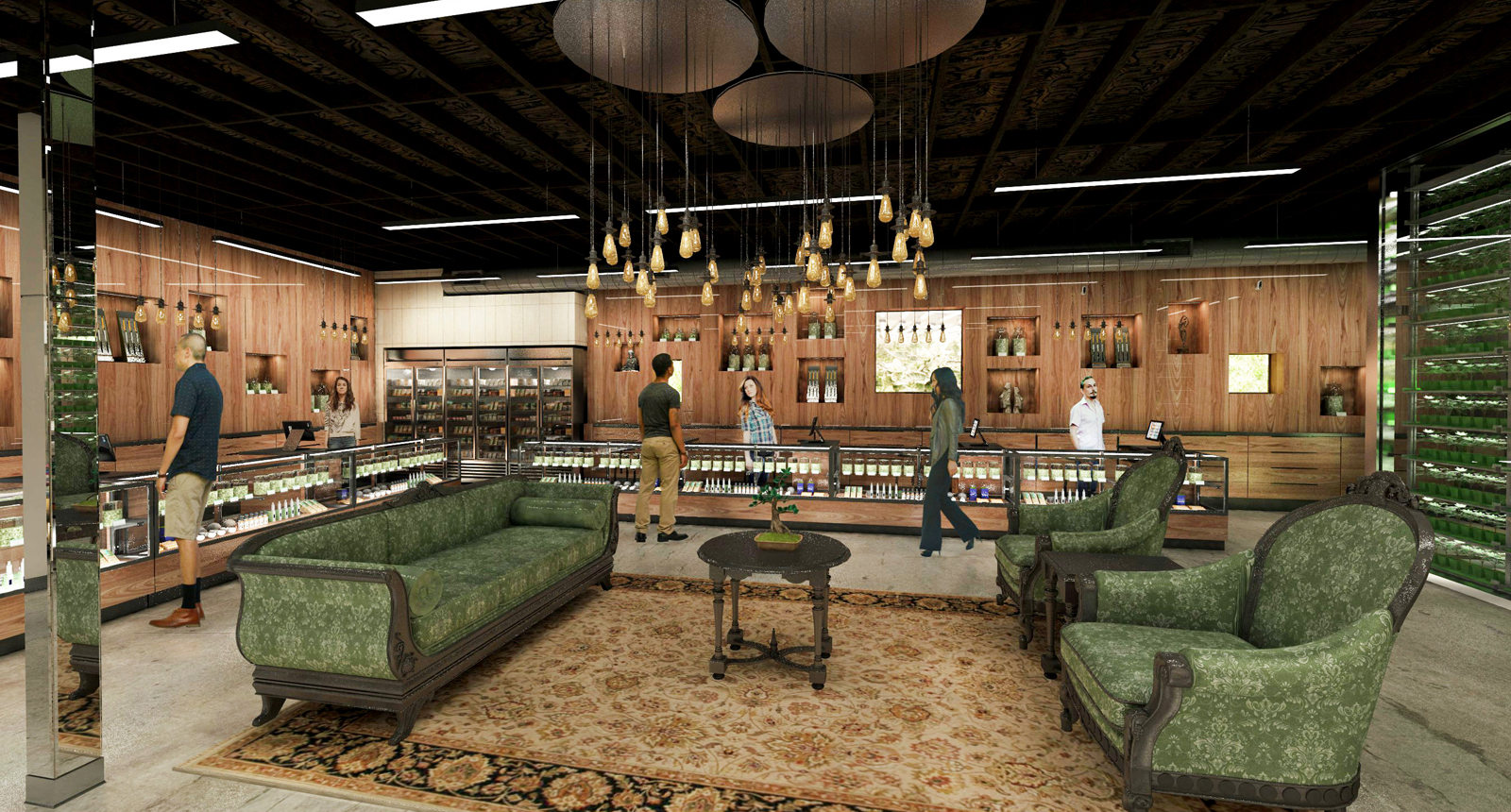One of the many exciting things about how the cannabis industry is evolving in California is that legalization has provided a new way for all players to communicate with each other and share. I think there’s plenty of room for innovation in the field.
The adventure in new types of retail
Cannabis dispensaries were a unique mix of what used to be a grocery store and a pharmacy. Increasingly, they’re evolving into a pharmacy / high end retail experience. Gone are the days of cramped cluttered tables, worn carpets, house-plants, glass pipes and bongs. We’re moving into an era of the small, obscure locations becoming more mainstream retail, but with very different design factors.
The recreational vs. the medicinal cannabis customer
The current client base wants to feel like they’re shopping rather than retrieving a prescription. One of our clients made an interesting discovery; as soon as cannabis was legalized, they were surprised by the number of people who wanted to dis-enroll as medical users, and not because they were actually recreational users, but because of two primary considerations:
- They didn’t want the burden of having a label. Perhaps this stems from the nature of the work it takes for medicinal users to arrive at cannabis as a solution. In the past, its benefits were eschewed by mainstream medicine, so frequently there’s an aspect of self-discovery and independent self-care put in to find ways of obtaining the medical cannabis, even though it is legal.
-
They wanted the freedom not use the medical card for entry. Many patients desperately need a reasonable treatment, but they are weary of being treated with pity or supervision by the state. Being able on one less registry is viewed as a benefit.
Black-market is still lurking about
Just after legalization went into effect in the beginning of 2018, local dispensaries expected a jump in sales, which happened, but then was followed by a dip, which came as a surprise. It took a little while, but several owners feel they have notion why. The current enforcement structure at the local city and county level is very sporadic and varies wildly between jurisdictions. As regulations rapidly develop and change, along with the fact that many cities still do not allow dispensaries or other cannabis facilities, the opportunity for delivery services has become a hot business that is somewhat immune to the requirements that dispensaries have.
In short, enforcement of sourcing has yet to catch up with delivery services. This means that the likelihood of black-market sourcing is very high. In the local market, a good percentage of experienced customers move very quickly to the most cost effective source. This will change when state and local enforcement improve.
There’s also a longer term and well known effect that we need to compete with, which is the ‘Amazon effect.’ The method to counter this is to create more value in the visit. The experience of visiting and finding value in the interaction and environment of the retail experience brings the customers back in for repeat business and solidifies the relationship.

Attribution-NoDerivs
CC BY ND
Best Buy has this same challenge, and led to the creation of its “Geek Squad” to provide individual, personalized customer service. In order to compete for online retail, it’s important to provide what customers can’t get online, which is direct interaction about the product or an interpersonal interaction that can’t be substituted. The latter is where cannabis dispensaries need to focus.
There is also the corollary challenge of customers walking in, getting the desired information, then walking out without a purchase, instead to order online. To reduce this kind of ‘breeze by,’ our design reflects an approach to making an appealing environment that enhances the experience and service that the customers truly want.
For dispensaries, this has the effect of suppressing the value of all types of cannabis product and shifting the tax burden to the brick and mortar stores. I think that cities and states need to step up and protect the members of their communities that are playing by the rules and work on better enforcement of legal sourcing. Sales are climbing again, but slowly and it’s not the gold rush the local cities think it is, at least not yet.

Interior of Dispensary
Attribution-NoDerivs
CC BY ND
Program
There’s an interesting balance between security, performance, retail, and even a little grocery produce (but that is already going away).
To best express what the new cannabis dispensary is, we take the product security aspect from a jewelry store, and combine that with the care and material tracking of a pharmacy. We don’t want the DMV vibe you get by waiting. I then throw in a dash of boutique clothing store décor and a bit of high end grocery since an increasing portion of the experience is edibles. It creates an interesting mix.
Then we get into how each dispensary interacts with their customers. I’ll use Zee Handoush of 7 Stars Healing as a fairly unique example. 7 Stars has years of experience in the medicinal side of the business and treats each patient with care. They have a station for each of their staff to discuss and show the wide variety of products and have them within reach at the retail station. There is a considerable amount of information to share, and since the available products change constantly and the needs and interests of the patients also change, the help of a knowledgeable guide is a far better than trying to wade through the internet. The approach by Zee to accommodate those conditions is much better suited to a relaxed one on one conversation. Other dispensaries have more show cases and displays that share new product information, but Zee has found that his client base likes to have more personal interaction, and my design for their dispensary reflects that. Thus, we get the unique expression of their style and service.
I want to give credit to Larrisa Sand of Sand Studios for a discussion I had with her about her work on the San Francisco dispensary “Spark”. Her experience in what worked and what more importantly what did not work was informative.
The requirements and challenges for each retailer and their brand are constantly changing and we’ve come up with an approach that is riding that wave. It’s exciting and we’re thrilled to be on the cutting edge of new types of “green” architecture. Interactive Resources, Inc. provides a broad range of services for the cannabis industry with extensive experience in the design of grow operations and more recently processing, extraction (soon to be published), distribution, packaging and larger campus design.

